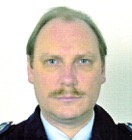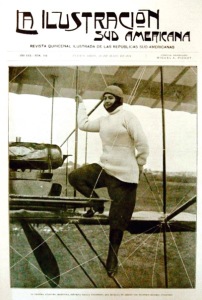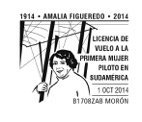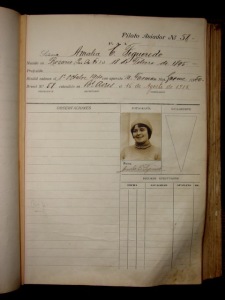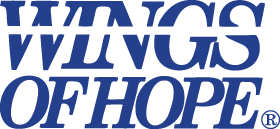Centenario de la obtención de la licencia de vuelo de la primera mujer en Argentina y en América del Sur
November 7, 2014
�
�
�
�
Amalia Celia Figueredo fue la primera mujer en Argentina y en Sudamérica en recibirse de piloto de avión, el 1° de octubre de 1914. Recibió la licencia N° 58 del Aero Club Argentino. El Centenario de la efemérides fue celebrado con un emotivo acto en el Museo Nacional de Aeronáutica.
Nació en Rosario, Santa Fe, el 18 de febrero de 1895. Cuando su familia se mudó a Buenos Aires, comenzó a frecuentar el aeródromo de Villa Lugano, ubicado en cercanías de su domicilio. Allí conoció a Jorge Newbery, que concurría a su casa para pedir que enfríen botellas de agua en el aljibe “para los muchachos del Aero Club”, y tuvo la oportunidad de realizar un corto vuelo “de bautismo”, invitada por Newbery, acompañando a Pablo Castaibert. Las nuevas sensaciones que experimentó, la llevaron a interesarse en esa actividad que se consideraba privativa para los varones: comenzó sus prácticas de aviación con el piloto Pablo Castaibert, a bordo de un aeroplano Castaibert-Anzani, de 25 HP de potencia, con resultados adversos, pues en el avión no cabía el instructor, y por eso, en cada intento de carreteo rompía la aeronave.
�
Participó en dos vuelos muy interesantes: con el piloto Ricardo Detomassi, volaron desde Villa Lugano a San Fernando en un biplano Marichal, propiedad del señor González, utilizando 01:17 horas. Regresaron, en la misma aeronave, 17 días después, en 35 minutos solamente, pues tuvieron viento de cola. Luego, se presentó en la escuela Paillette, en San Fernando, que era dirigida por Enrique A. Roger, continuó su aprendizaje allí con el francés Marcel Paillette, logrando rendir su examen de vuelo definitivo, el 01 de octubre de 1914, a bordo de un biplano Farman. Con el Farman, que era un biplano mucho más grande, ya podía hacer prácticas con instructor a bordo, lo que permitió avanzar con su aprendizaje, y recibió su licencia de vuelo N° 58, emitida por el Aero Club Argentino. Para ese vuelo, fue fiscalizada por el ingeniero Irmscher y el señor Borcosque, que fueron designados comisarios por el Aero Club Argentino. Después de realizar algunos vuelos de demostración en su Rosario natal, con un accidente incluido, prometió a su novio que abandonaría la actividad aérea cuando se casaran. Efectivamente, se casaron el 13 de noviembre de 1915, y Amalia Celia Figueredo de Pietra dejó de volar.
Aplazan apertura ofertas concesión Aeropuerto Arturo Merino Benítez
November 7, 2014
Con el objetivo de garantizar el proceso y ante la gran cantidad de preguntas que los interesados en participar en la concesión del nuevo terminal del aeropuerto Arturo Merino Benítez han formulado y a las cuales hay que dar adecuada respuesta, el Ministerio de Obras Públicas, a solicitud de la Dirección General de Aeronáutica Civil, mandante de la concesión, ha decidido ampliar hasta el 30 de diciembre la apertura de las propuestas de carácter técnico y hasta el 4 de febrero del 2015 la apertura de las de carácter económico.
No obstante ello, se espera que la adjudicación pueda realizarse en abril del año venidero.
Dassault Aviation: Preparing for the Future of Combat Aerospace
November 7, 2014
Dassault Aviation, BAE Systems and their industrial partners have been
awarded a [Eur]150m/[Pounds]120m contract by the French and UK
governments for a two year co-operative Future Combat Air System (FCAS)
Feasibility Phase study, formally signaling the start of work. This is
the first step towards what could become a full demonstration programme
that shapes the future of combat aerospace in Europe.
SAINT-CLOUD, France, Nov. 5, 2014 (GLOBE NEWSWIRE) — Following the
political-level agreement announced at the Farnborough Air Show in July
this year, Dassault Aviation and BAE Systems are pleased to have been
awarded a two-year contract by the French and UK governments to help
define the Franco-British requirement for a Future Combat Air System
(FCAS) programme.
The contract was officially awarded to Eric Trappier, Chairman and CEO
of Dassault Aviation, and Ian King, CEO of BAE Systems, by the heads of
the French and British defence procurement agencies, Laurent
Collet-Billon, Delegue General pour l’Armement for the French DGA, and
Bernard Gray, Chief of Defence Materiel for the UK MoD, during a
ceremony at Dassault Aviation’s headquarters, Saint Cloud, France.
Eric Trappier said: “We welcome this new step, which prepares the
future of both manned and unmanned combat air systems. It ensures
French and British companies to maintain their technological excellence
which is vital to their competitiveness in a globalized environment. It
mainly shows the commitment of France and Britain in their ambition to
remain leading aviation powers”.
Ian King said: “This contract award is a key step in the partnership
between our two nations, governments, and industries. The Feasibility
Phase will allow UK and French industry to work closely together and
provide a strong foundation for a potential follow-on Future Combat Air
System Demonstration programme as well as supporting a number of highly
skilled jobs.”
Cooperation between France and the UK is seen as the optimum way to
progress a UCAS (Unmanned Combat Air System) solution, whilst
supporting both governments’ intentions for closer defence ties. The
joint study contract of [Eur]150m/[Pounds]120m is to be supplemented
with additional French and UK national funding to the combined value of
[Eur]100m/[Pounds]80m in the same period.
The two-year study will build the foundations on which a long-term
joint programme will be based by focusing on the following key points:
– The development of concepts for an operational system, and- The
maturation of key technologies that will be required for a future
operational UCAS.
Following the completion of the study at the end of 2016, work could
then commence on a UCAS demonstration development programme that
addresses both nations’ future military requirements.
The Feasibility Phase will sustain hundreds of highly skilled jobs at
Dassault Aviation and BAE Systems with more jobs sustained by
Rolls-Royce, Selex ES, Snecma (Safran), Thales and SME’s involved in
the programme. In addition, the contract supports the strategically
important Military Aerospace Industries in both nations and is
testament to the importance that the French and UK governments place in
maintaining a cutting edge, sovereign military air capability.
Surf Air Takes Delivery of their First Pilatus PC-12 NG
November 7, 2014
The innovative all-you-can-fly private membership travel company begins expansion of its fleet to accommodate rapid subscriber growth.
In a ceremony held yesterday at Pilatus Business Aircraft Ltd’s facility in Broomfield, Colorado, Surf Air took delivery of PC-12 NG serial number 1490, with the registration number N809SA. The aircraft, sporting Surf Air’s unique new fleet paint scheme, is the first of fifteen firm aircraft the membership-based airline ordered from Pilatus earlier this year.
This newest aircraft joins a fleet of three “Legacy” PC-12s Surf Air employed initially to introduce their business model. Two additional new PC-12 NGs will join the fleet by the end of this year. As new aircraft come on line, the older Legacy PC-12s will eventually be phased out and replaced with PC-12 NGs featuring the Honeywell Primus Apex integrated avionics system, a higher horsepower Pratt & Whitney PT6A-67P engine, and customized BMW DesignworksUSA executive interiors.
The delivery of the first three new aircraft this year in Surf Air’s fleet will allow the company to expand its service to Carlsbad, California, beginning November 18 and Oakland, California, beginning December 15. Surf Air will take delivery of additional aircraft ordered in 2015 and 2016 before making a decision on exercising up to 50 additional options it has for future PC-12 NG delivery positions.
Surf Air’s innovative business model provides frequent regional business and leisure travelers with a sophisticated and hassle-free air travel experience that saves valuable time and money. The company operates Pilatus PC-12s in executive interior configuration to and from convenient airports in the San Francisco Bay Area, Los Angeles Metro Area, Santa Barbara and Truckee Lake Tahoe, with service to additional locations to follow.
�
Crece intercambio de turistas entre Chile y los Estados Unidos
November 4, 2014
En un 9,3% creció la llegada de turistas a Chile en septiembre procedentes de los Estados Unidos en relación al año pasado y en un 21% aumentó la cifra de chilenos que han viajado al país del norte.
Lo anterior se atribuye a la entrada en vigencia del programa de exención de visa o Visa Waiver que los Estados Unidos otorgaran a los chilenos, lo que a su vez motivara a Chile a eliminar el impuesto de reciprocidad que se cobraba a los estadounidenses al ingresar al país.
Boeing Completes Testing on New Anti-Jamming Technology
November 4, 2014
Demonstrations prove added capability for on-orbit wideband and commercial satellite platforms
EL SEGUNDO, Calif., Nov. 4, 2014 – Boeing [NYSE: BA] has proven its new anti-jamming communications technology is capable of operating as either a ground-based user terminal or satellite-based networking hub, enabling the military to send and receive secure communications at a significantly lower cost by using existing terminals and satellites.
The anti-jam technology uses a protected tactical waveform, which shields signals from interference by adversaries or cyber-terrorists. This demonstration complements previous on-orbit demonstrations over satellites like ViaSat-1 and the sixth Wideband Global SATCOM (WGS-6), showing the ability to operate anti-jam waveforms over existing commercial and military spacecraft.
“We’ve confirmed this technology can be applied quickly and affordably to existing assets, especially operational WGS satellites and ground terminals,” said Dan Hart, vice president of Boeing Government Satellite Systems. “With threats to secure communications becoming increasingly frequent and sophisticated, providing this enhanced capability to warfighters on the ground is critical.”
The recent test was conducted between a Boeing ground terminal using a programmable modem, designed and developed by ViaSat using one of its commercial off-the-shelf platforms and a ground terminal designed and built by MIT-Lincoln Laboratory.
This testing, done under contract for the U.S. Air Force Space and Missile Systems Center and supervised by the U.S. government, confirms that the modem meets technical interface specifications, while successfully transmitting information to and from the ground user terminal.
Participación de FARO en EMAF 2014 Oporto
November 4, 2014
La feria de Maquinaria, Equipos y Servicios para la Industria se celebrará del 19 AL 21 de noviembre en Portugal
FARO participará este próximo mes de noviembre en la feria de la Industria de Portugal, EMAF 2014, que este año se celebra en Oporto, concretamente, en las instalaciones del recinto ferial Exponor.
En la Feria Internacional de Maquinaria, Equipos y Servicios para la Industria, FARO contará con un stand en el pabellón 5, nº D30. Se trata de un evento destinado exclusivamente a profesionales, en el cual se mostrarán las últimas novedades, innovaciones y avances del Sector Industrial.
En dicho salón, el proveedor líder mundial de soluciones portátiles de medición y captura de imágenes presentará un nuevo e innovador producto: el FARO Edge ScannArm HD, desarrollado para marcar un nuevo estándar en la tecnología de escaneado láser 3D y, que genera datos de alta definición con una velocidad y cobertura de superficie superiores a un precio asequible. Ello le permite reducir los tiempos de medición in situ, escanear materiales muy complejos y mejorar considerablemente los productos y procesos.
El Edge ScanArm HD ofrece una rápida recopilación de nubes de puntos con una resolución extrema y una precisión elevada; todo en un sistema compacto y fácil de usar. Las nuevas funciones facilitan la posibilidad a los usuarios de escanear sin problema una amplia gama de materiales independiente del color, la reflectividad o complejidad de la pieza sin necesidad de aplicación de sprays o la colocación de pegatinas de fotogrametría.
También, el aumento de anchura de línea de escaneo y la alta velocidad impulsan la productividad, aumentando la cobertura y reduciendo el tiempo de escaneado. Así, los componentes más complejos se pueden capturar al detalle gracias a los 2.000 puntos reales por línea de escaneo y el nuevo láser azul con tecnología de reducción del ruido.
Por todo ello, el FARO Edge ScanArm HD es la herramienta ideal para el desarrollo de productos, inspección y control de calidad, ofreciendo funciones como la comparación de nubes de puntos con CAD, la creación rápida de prototipos, la ingeniería inversa y el modelado 3D.
Debido a su importancia, EMAF 2014 Oporto, contará con la presencia de las mejores empresas y profesionales del Sector. El evento se ha convertido en una cita casi ineludible para todos ellos, tanto por las novedades que se presentan, como por los importantes contactos que se pueden establecer.
IAI’s TaxiBot®, A SEMI-ROBOTIC PILOT CONTROLLED VEHICLE FOR DISPATCH TOWING, MAKES HISTORY
November 4, 2014
Taxibot® Background:
Airplanes were made to fly, not to taxi
IAI’s innovative TaxiBot® introduces a new concept for an alternative taxiing system for commercial airplanes. TaxiBot is a semi-robotic pilot controlled vehicle designed to transport airplanes from the airport gate to the runway and back, without using the airplane’s engines.
TaxiBot provides the required power to move the airplane and has achieved a world record of 23 knots taxiboting with fully loaded Boeing 737 and Airbus A320 airplanes, without the need to change or replace the airplane’s APU (auxiliary power unit).
�
TaxiBot can be used with either narrow or wide body airplanes, and does not increase the airplane’s weight or reduce its cargo space, as no modifications to the airplane’s systems are required. TaxiBot allows the pilot full control of the system, and operation is performed using the airplane’s tiller and brake pedals as in regular taxiing. Multiple patents were filed and granted worldwide for TaxiBot systems and concept.
Commercial airplane engines are very efficient in flight at high altitudes, but not when operated on the ground. During taxiing these engines burn considerable amounts of fuel, emit substantial amounts of CO2, are vulnerable to Foreign Object Damage (FOD) and create significant noise in airports and their surrounding areas.
The WB TaxiBot started dynamic testing at the New TLD factory in Sorigny, France, inaugurated on September 2014 for TaxiBot production. The WB TaxiBot will be suitable for all twin aisle airplanes; A330, A340, A350, A380, B747, B767, B777 and B787. The certification tests of the WB TaxiBot with a WB airplane is schedule for the third quarter of 2015 aiming to get STC for the first WB airplane type by the end of the year.
�
A typical Boeing 747 or Airbus 320 fuel consumption for a seventeen-minute taxi before takeoff is approximately one ton of fuel (1,250 liters). TaxiBot operation will reduce it by eighty-five percent. In comparison, for the same taxiing procedure, TaxiBot itself consumes only twenty-five to thirty liters of fuel. The same B747 or Airbus 320 airplane’s engines emit 3.2 tons of CO2, while TaxiBot emits less than sixty kgs. This will result in savings of millions of dollars a year for airline operators and billions of dollars a year for the commercial airline industry.
�
Overall worldwide taxiing costs in 2020 are estimated at over $8.4B per year. Taxiing using TaxiBot has the potential to reduce these costs to less than $3B per year.
�
Substantial reduction in CO2 emissions is achieved by using TaxiBot, regardless of the flight range. The system reduces cases of FOD by fifty percent. In addition, recent tests in Frankfurt have shown that taxiing with TaxiBot reduced the noise level by fifty percent, compared to normal taxiing with jet engines. Moreover, the noise level is reduced to below eighty db. which is considered to be safe for humans.
TaxiBot provides an economic and effective solution to the current taxiing methods by using hybrid diesel electric power instead of hydrostatic drive; this results in optimal efficiency, maintainability and avoidance of hydraulic leaks on airports’ tarmacs.
�
328 Support Services GmbH announces a major upgrade of Dornier 328 avionics system.
November 4, 2014
328 Support Services GmbH, the Type Certificate holder for the D328 Jet and turboprop aircraft, is pleased to announce the commencement of a major cockpit upgrade programme for the aircraft. The programme, which has just commenced, is expected to be certified by EASA and the US FAA by late 2016.
In partnership with the current avionics system provider and a number of strategic customers, the existing flight deck will be enhanced with features that will include:
• Compliance with ADS-B out requirements.
• New Primus Elite LCD displays that save weight and provide enhanced features such as charts and maps, enhanced vision, video display capabilities and synthetic vision, which will be available as an option.
• A second FMS option will be available for the first time on the D328 turboprop aircraft allowing WAAS-LPV and remote and oceanic operations.
• The capability to provide PM-CPDLC communications with ground based stations.
• Smart Runway and Smart Landing upgrade capability
• A Class 3 Electronic flight bag.
Dave Jackson, Managing Director of 328 Group, commented: “This upgrade programme, which will be overseen by our engineering team in Oberphaffenhofen, Germany, will ensure that the D328 aircraft has the opportunity to operate in all areas of the world in compliance with all known regulatory requirements for many years to come.”
Embraer realiza Encontro Mundial de Operadores de E-Jets
November 3, 2014
Marco Island – FL, Estados Unidos, 3 de novembro de 2014 – A Embraer Aviação Comercial reúne mais de 50 companhias aéreas e empresas de leasing, além de 40 fornecedores e parceiros comerciais, em Marco Island, na Flórida, nos Estados Unidos, para a edição mundial da Conferência de Operadores de E-Jets da Embraer (Embraer Operators Conference – EOC). O evento, que tem como tema o marco de dez anos da entrada em operação dos E-Jets, celebrados em março deste ano, ocorre nos dias 3 a 4 de novembro e precede a 14ª edição do Workshop de Custos de Manutenção (Maintenance Cost Workshop – MCW), promovida pela área de Serviços & Suporte da Embraer Aviação Comercial no dia 5.
“Reunir fabricante, operadores e fornecedores é uma maneira eficaz de trocar informações e experiências de operação e manutenção, buscando aumentar a eficiência operacional das companhias aéreas que operam os E-Jets, fator determinante para guiar nossa inovação no suporte ao cliente”, disse Johann Bordais, Diretor de Serviços e Suporte da Embraer Aviação Comercial. “Por isso, temos investido em avançadas ferramentas de gerenciamento de diagnóstico de manutenção, para tornar as nossas aeronaves sempre mais disponíveis, o que, em última instância, impulsiona a rentabilidade operacional dos nossos clientes.”
Tanto na EOC quanto no MCW a Embraer promoverá as e-Solutions, ferramentas baseadas na plataforma do site FlyEmbraer, que é um ponto único de conexão para os clientes da Embraer encontrarem um portfólio de serviços digitais a qualquer momento, em qualquer dispositivo. Projetado para maximizar a duração do voo e evitar custos operacionais desnecessários e atrasos, serve tanto para manutenção corretiva quanto preventiva.
A Embraer fornece suporte para operadores de jatos e aviões turboélices em todo o mundo, com conhecimento técnico e vasta rede de serviços e fornecimento de componentes. Os resultados são economia significativa em custos com reparo e inventário, reduzindo o espaço de armazenamento necessário para estoques, praticamente eliminando a necessidade de recursos para a gestão de reparos, e, finalmente, garantindo níveis de desempenho.
Em 2014, a Embraer assinou importantes contratos para apoiar as frotas de seus clientes. A SkyWest, por exemplo, fechou um acordo de 12 anos para serviços de gerenciamento de componentes, pelo qual a Embraer fornecerá suporte para toda a frota dos jatos E175. O acordo contempla mais de 160 peças de reposição. A Embraer assinou também contrato de 10 anos com a empresa para fornecer o sistema AHEAD-PRO (Aircraft Health Analysis and Diagnosis – PROgnosis, em inglês). Já a Tianjin Airlines, primeiro cliente do jato E190 na China e maior operador de E-Jets na Ásia, se tornou o cliente de lançamento no país para o sistema AHEAD-PRO. O sistema será instalado em toda a frota de 50 E-Jets da Tianjin Airlines.
O MCW é um evento anual organizado para apoiar os operadores na redução dos custos de manutenção por meio do compartilhamento de experiências, abordando as melhores práticas de mercado, atendendo à contínua demanda pelo aumento da eficiência operacional.
Os E-Jets detêm mais de 50% de participação de mercado em encomendas e 60% das entregas no segmento de jatos de 70 a 130 assentos. Atualmente, os E-Jets operam com 65 empresas aéreas em 45 países.
<

